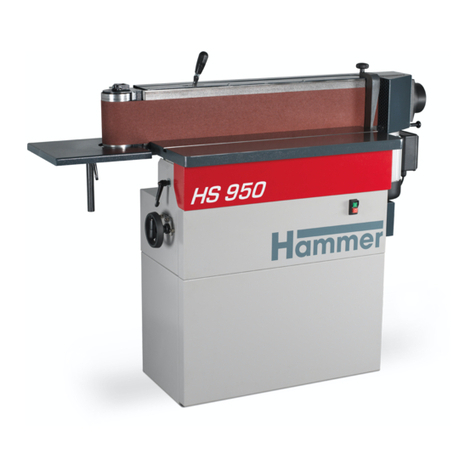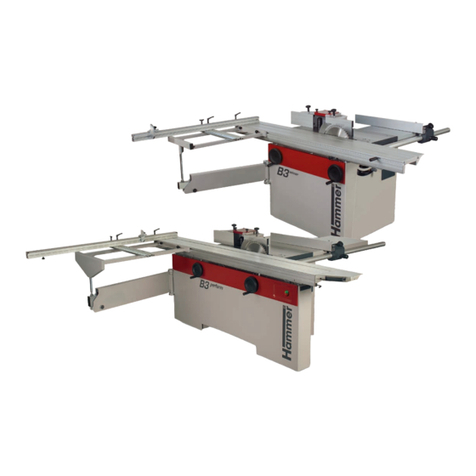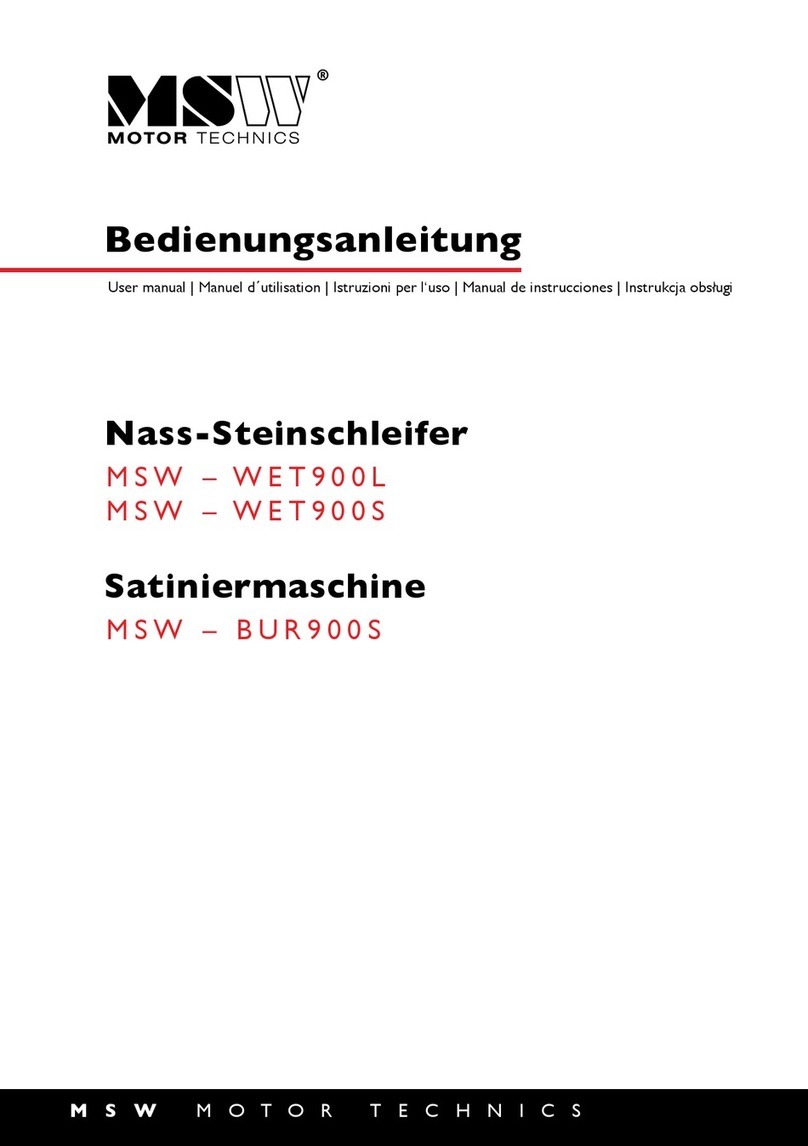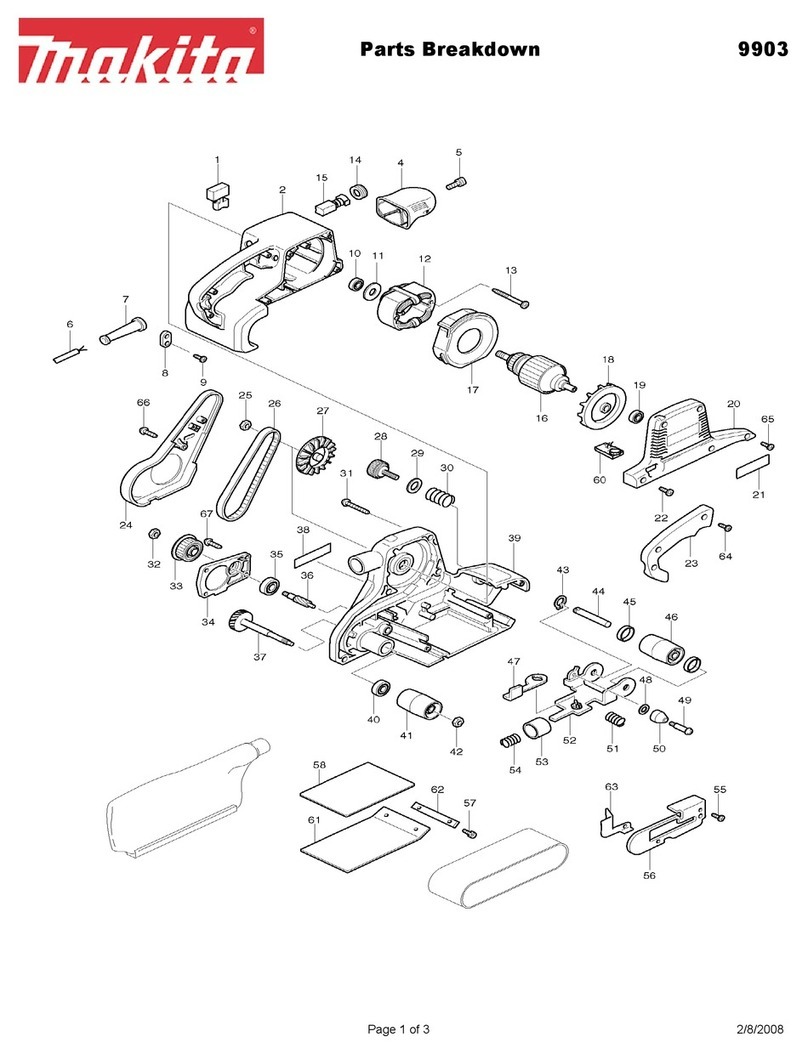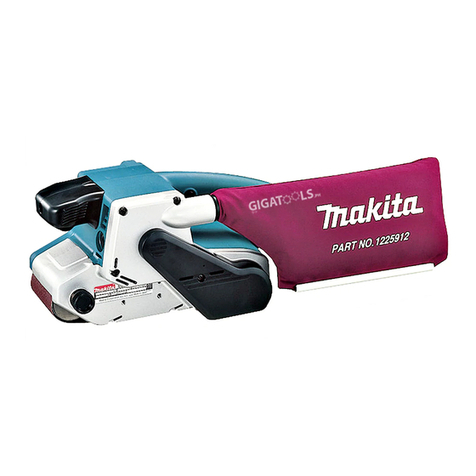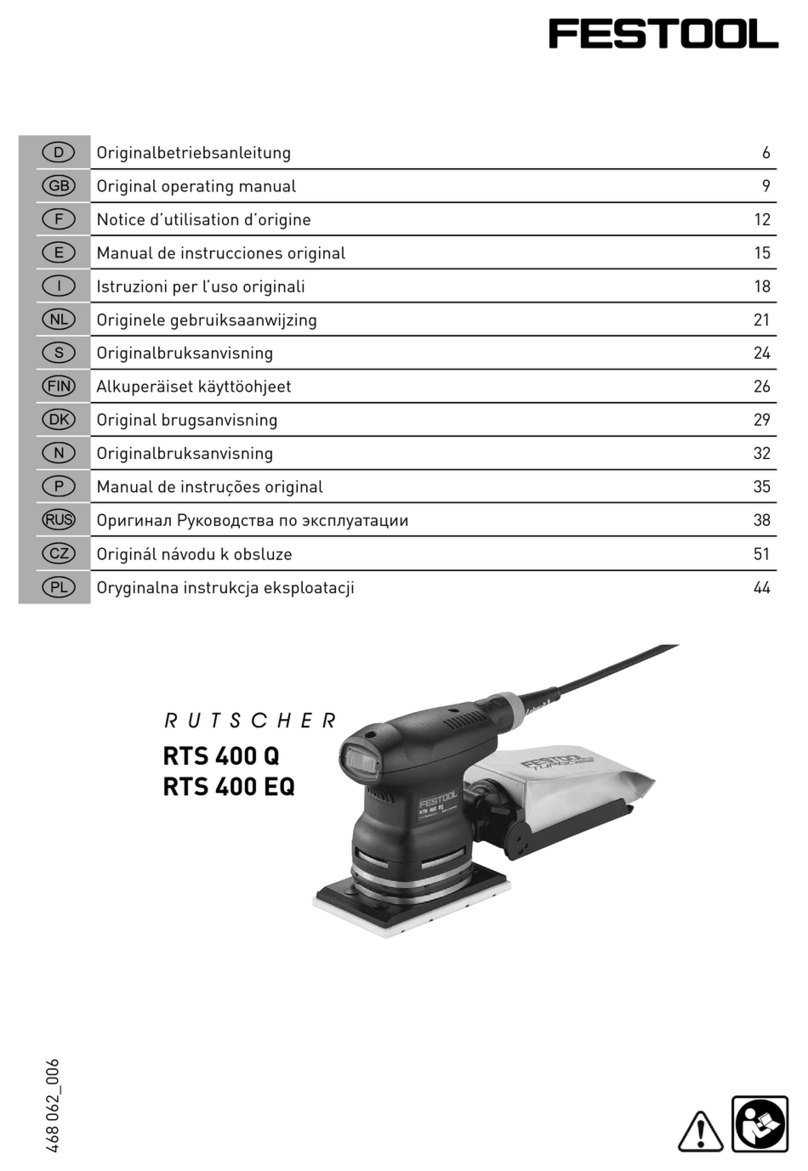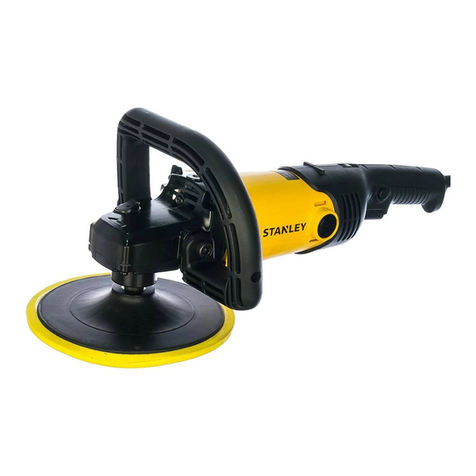Hammer HS 2200 User manual

Keep this manual handy and in good condition for continual reference!
User Manual
Belt Sanders
HS 2200

2
3
Belt Sanders
HS 2200
Belt Sanders
HS 2200
For the safety of all personnel, it is necessary to conscientiously study this manual before assembly and
commissioning. This manual must be kept in good condition, as it belongs to the machine! Furthermore,
keep the manual to hand and in the vicinity of the machine so that it is accessible to personnel when they
are using, maintaining or repairing the machine.
Attention! The machine must be inspected immediately on arrival. If the machine was damaged during
transport or if any parts are missing, a written record of the problems must be submitted to the forwarding
agent and a damage report compiled. Be sure also to notify your supplier immediately.
© Felder KG
KR-Felder-Str. 1
A-6060 Hall in Tirol
Tel.: +43 (0) 5223 5850 0
Fax: +43 (0) 5223 5850 62
E-mail: info@hammer.at
Internet: www.hammer.at
06. März 2007
HAMMER A product of the FELDER GROUP

2
3
Belt Sanders
HS 2200
Belt Sanders
HS 2200
Table of contents
Table of Contents
1 General ...........................................................................................................................5
1.1 Explanation of symbols ...................................................................................5
1.2 Information about the manual ..........................................................................5
1.3 Liability and warranty.....................................................................................6
1.4 Copyright......................................................................................................6
1.5 Warranty notice.............................................................................................6
1.6 Spare parts ...................................................................................................6
1.7 Disposal .......................................................................................................7
2 Safety ...........................................................................................................................8
2.1 Intended use..................................................................................................8
2.2 Manual contents ............................................................................................8
2.3 Making changes and modifications to the machine ............................................8
2.4 Responsibilities of the owner operator...............................................................9
2.5 What is required of personnel .........................................................................9
2.6 Work safety ..................................................................................................9
2.7 Personal safety.............................................................................................10
2.8 Hazards arising from the machine..................................................................10
2.9 Other risks ..................................................................................................11
3 Declaration of Conformity ..................................................................................................12
4 Technical data ...................................................................................................................13
4.1 Dimensions and weight.................................................................................13
4.2 Operation and storage conditions ..................................................................13
4.3 Electrical connection.....................................................................................14
4.4 Particle emissions .........................................................................................14
4.5 Dust extraction .............................................................................................14
4.6 Noise emission ............................................................................................15
5 Setting up the machine....................................................................................................... 16
5.1 Overview....................................................................................................16
5.2 Data plate...................................................................................................17
6 Transport, packaging and storage ......................................................................................18
6.1 Safety instructions ........................................................................................18
6.2 Transport.....................................................................................................18
6.3 Transport inspection......................................................................................19
6.4 Packaging...................................................................................................19
6.5 Storage.......................................................................................................19
A product of the FELDER GROUP

4
5
Belt Sanders
HS 2200
Belt Sanders
HS 2200
Table of Contents
7 Setup and installation ........................................................................................................20
7.1 Safety instructions ........................................................................................20
7.2 Electrical connection.....................................................................................20
7.3 Installation ..................................................................................................21
7.4 Unloading...................................................................................................21
7.4.1 Assembling the machine ...............................................................................21
7.5 Dust extraction.............................................................................................24
8 Making adjustments and preparations................................................................................25
8.1 Safety instructions ........................................................................................25
8.2 Sanding belt................................................................................................25
8.2.1 Allowed sanding belts ..................................................................................25
8.3 Table height adjustment and maneuvering.......................................................26
8.4 Sanding carriage.........................................................................................26
8.5 Infeed fence ................................................................................................26
8.6 Mounting/adjusting the sanding belt ..............................................................27
9 Operation .........................................................................................................................28
9.1 Safety instructions ........................................................................................28
9.2 Switching on the machine .............................................................................29
9.3 Control points during test sanding ..................................................................29
9.4 Switching off the machine .............................................................................29
9.5 Emergency stop ...........................................................................................30
9.6 Working techniques .....................................................................................30
9.6.1 Permitted working techniques.........................................................................30
9.6.2 Prohibited working techniques .......................................................................30
9.6.3 Sanding surfaces .........................................................................................30
9.6.5 Sanding on the upper sanding surface............................................................31
10 Maintenance .....................................................................................................................32
10.1 Safety instructions ........................................................................................32
10.2 Periodic service............................................................................................32
10.2.1 Height adjustment spindle .............................................................................32
10.2.2 Table guides and Sanding carriage bar..........................................................33
10.2.3 Belt rollers ...................................................................................................33
11 Faults .........................................................................................................................34
11.1 Safety instructions ........................................................................................34
11.2 What to do if a fault develops .......................................................................34
11.3 What to do after rectifying the fault................................................................34
11.4 Faults, causes and repairs .............................................................................35
14 Index..................................................................................................................................36

4
5
Belt Sanders
HS 2200
Belt Sanders
HS 2200
General
Attention:
This symbol marks tips and information which should be observed to ensure efficient and failure-free op-
eration of the machine.
Attention: Risk of material damage!
This symbol marks instructions which, if not observed, may lead to material damage, functional failures
and/or machine breakdown.
Warning: Risk of injury or death!
This symbol marks instructions that must be followed in order to avoid harm to one‘s health, injuries, per-
manent impairment or death.
1 General
1.1 Explanation of symbols
Important technical safety instructions in this manual are
marked with symbols.
These instructions for work safety must be followed. In all
these particular cases, special attention must be paid in
order to avoid accidents, injury to persons or material
damage.
Warning: Danger – electric current!
This symbol warns of potentially dangerous situations related to electric current. Not observing the safety
instructions increases the risk of serious injury or death. Required electrical repairs may only be carried out
by a trained electrical technician.
1.2 Information about the manual
This manual describes how to operate the machine
properly and safely. Be sure to follow the safety tips and
instructions stated here as well as any local accident
prevention directives and general safety regulations.
Before beginning any work on the machine, ensure that
the manual, in particular the chapter entitled „Safety“
and the respective safety guidelines, has been read in its
entirety and fully understood. This manual is an integral
part of the machine and must therefore be kept in the
direct vicinity of the machine and accessible at all times.
If the machine is sold, rented, lent or otherwise trans-
ferred to another party, the manual must accompany the
machine.

6
7
Belt Sanders
HS 2200
Belt Sanders
HS 2200
1.3 Liability and warranty
The contents and instructions in this manual were com-
piled in consideration of current regulations and state of
the art technology as well as based on our know-how
and experience acquired over many years. This manual
must be read carefully before commencing any work on
or with this machine. The manufacturer shall not be liable
for damage and or faults resulting from the disregard of
instructions in the manual. The texts and images do not
necessarily represent the delivery contents. The images
and graphics are not depicted on a 1:1 scale. The actual
delivery contents are dependent on custom-build specifi-
cations, add-on options or recent technical modifications
and may therefore deviate from the descriptions, instruc-
tions and images contained in the manual. Should any
questions arise, please contact the manufacturer. We
reserve the right to make technical modifications to the
product in order to further improve user-friendliness and
develop its functionality.
1.4 Copyright
This manual should be handled confidentially. It is desig-
nated solely for those persons who work on or with the
machine. All descriptions, texts, drawings, photos and
other depictions are protected by copyright and other
commercial laws. Illegal use of the materials is punish-
able by law.
This manual – in its entirety or parts thereof – may not
be transferred to third parties or copied in any way or
form, and its contents may not be used or otherwise
communicated without the express written consent of the
manufacturer.
Infringement of these rights may lead to a demand for
compensation or other applicable claims. We reserve all
rights in exercising commercial protection laws.
1.5 Warranty notice
The guarantee period is in accordance with
national guidelines. Details may be found on our
website, www.felder-group.com
1.6 Spare parts
Use only genuine spare parts supplied by the manufac-
turer.
Attention: Non gnuine, counterfeit or faulty spare parts may result in damage, cause malfunction or com-
plete breakdown of the machine.
If unauthorized spare parts are installed in the machine,
all warranty, service, compensation and liability claims
against the manufacturer and their contractors, dealers
and representatives shall be rejected.
Attention: A list of authorised genuine spare parts and part numbers can be found at the end of this oper-
ating manual.
General

6
7
Belt Sanders
HS 2200
Belt Sanders
HS 2200
General
1.7 Disposal
If the machine is to be disposed of, separate the compo-
nents into the various materials groups in order to allow
them to be reused or selectively disposed of. The whole
structure is made of steel and can therefore be disman-
tled without problem. This material is also easy to dis-
pose of and does not pollute the environment or jeopard-
Attention: Used electrical materials, electronic components, lubricants and other auxiliary substances must
be treated as hazardous waste and may only be disposed of by specialized, licensed firms.
ise public health. International environmental regulations
and local disposal laws must always be complied with.

8
9
Belt Sanders
HS 2200
Belt Sanders
HS 2200
2 Safety
At the time of its development and production, the ma-
chine was built in accordance with prevailing technologi-
cal regulations and therefore conforms to industry safety
standards.
However, hazards may arise should the machine be
operated by untrained personnel, be used improperly or
employed for purposes other than those it was designed
for. The chapter entitled „Safety“ offers an overview of
all the important safety considerations necessary to opti-
mise safety and ensure the safe and trouble-free opera-
tion of the machine.
Additionally, in order to further minimize risks, the other
chapters of this manual contain specific safety instruc-
tions, all marked with symbols. Besides the various
instructions, there are a number of pictograms, signs and
labels affixed to the machine that must also be heeded.
These must be kept visible and legible and may not be
removed.
2.1 Intended use
The belt sander HS 2200 is designed to provide superior
sanding results on large surfaces and frames. Working
materials other than wood is only permitted with the
express written consent of the manufacturer. Operational
safety is guaranteed only when the machine is used for
its intended purposes.
Attention: Any use se outside the machines intended purposes shall be considered improper and is there-
fore not permitted. All claims regarding damage resulting from improper use that are made against the
manufacturer and its authorized representatives shall be rejected. The operator shall be solely liable for
any damage that results from improper use of the machine.
The term „proper use“ also refers to correctly observing
the operating conditions as well as the specifications and
instructions in this manual.
The machine may only be operated with parts and origi-
nal and or genuine accessories from the manufacturer.
2.2 Manual contents
All those appointed to work on or with the machine must
have fully read and understood the manual before com-
mencing any work. This requirement must be met even
if the appointed person is familiar with the operation of
such a machine or a similar one, or has been trained
by the manufacturer. Knowledge about the contents of
this manual is a prerequisite for protecting personnel
from hazards and avoiding mistakes so that the machine
may be operated in a safe and trouble-free manner. It is
recommended that the operator request proof from the
personnel that the contents of the manual have in fact
been read and understood.
2.3 Making changes and modifications to the machine
In order to minimize risks and to ensure optimal perform-
ance, it is strictly prohibited to alter, retrofit or modify the
machine in any way without the express consent of the
manufacturer. All the pictograms, signs and labels af-
fixed to the machine must be kept visible, readable and
may not be removed. Pictograms, signs and labels that
have become damaged or unreadable must be replaced
promptly.
Safety

8
9
Belt Sanders
HS 2200
Belt Sanders
HS 2200
Safety
2.4 Responsibilities of the owner operator
This manual must be kept in the immediate vicinity of
the machine and be accessible at all times to all persons
working on or with the machine. The machine may only
be operated if it is in proper working order and in safe
condition. Every time before the machine is switched
on, it must be inspected for visible defects and general
condition. All instructions in this manual must be strictly
followed without reservation.
Besides the safety advice and instructions stated in this
manual, it is necessary to consider and observe local ac-
cident prevention regulations, general safety regulations
as well as current environmental stipulations that apply to
the operational range of the machine.
The operator and designated personnel are responsible
for the trouble-free operation of the machine as well
as for clearly establishing who is in charge of install-
ing, servicing, maintaining and cleaning the machine.
Machines, tools and accessories must be kept out of the
reach of children.
2.5 What is required of personnel
Only authorized and trained personnel may work on and
with the machine. Personnel must be briefed about all
functions and potential dangers of the machine. „Spe-
cialist staff“ is a term that refers to those who – due to
their professional training, know-how, experience, and
knowledge of relevant regulations – are in a position to
assess delegated tasks and recognise potential risks. If
the personnel lack the necessary knowledge for work-
ing on or with the machine, they must first be trained.
Responsibility for working with the machine (installation,
service, maintenance, overhaul) must be clearly defined
and strictly observed. Only those persons who can be
expected to carry out their work reliably may be given
permission to work on or with the machine. Personnel
must refrain from working in ways that could harm oth-
ers, the environment or the machine itself. It is absolutely
forbidden for anyone who is under the influence of
drugs, alcohol or reaction-impairing medication to work
on or with the machine. When appointing personnel to
work on the machine, it is necessary to observe all local
regulations regarding age and professional status. The
user is also responsible for ensuring that unauthorised
persons remain at a safe distance from the machine.
Personnel are obliged to immediately report to the opera-
tor any irregularities with the machine that might compro-
mise safety.
2.6 Work safety
Following the safety advice and instructions given in this
manual can prevent bodily injury and material dam-
age while working on and with the machine. Failure to
observe these instructions can lead to bodily injury and
damage to or destruction of the machine. Disregard of
the safety advice and instructions given in this manual as
well as the accident prevention regulations and general
safety regulations applicable to the operative range of
the machine shall release the manufacturer and their
authorised representatives from any and all liability and
compensation claims.

10
11
Belt Sanders
HS 2200
Belt Sanders
HS 2200
2.7 Personal safety
When working on or with the machine, the following
must be strictly observed:
Protective gear (overalls, safety goggles, dust mask, hairnet to contain long hair, etc.)
Sturdy, tight-fitting clothing (tear-resistant, no wide sleeves).
Persons with long hair who are not wearing a hairnet are not permitted to work on or with the machine.
It is prohibited to wear gloves while working on or with the machine.
All jewellery (rings, bracelets, necklaces, etc.) must be removed before starting work on or with the ma-
chine.
When working on or with the machine, the following must always be worn by personnel:
Protective footwear
That protects the feet from heavy falling objects and prevents sliding on slippery floors.
Ear protection
To protect against loss of hearing.
2.8 Hazards arising from the machine
The machine has undergone a hazards analysis. The
design and construction of the machine are based on the
results of this analysis and correspond to state-of-the-art
technology.
The machine is considered operationally safe when used
properly.
Nevertheless, there are some residual risks that must be
considered.
The machine runs with high electrical voltage.
Warning! Danger – electric current: Electrical energy can cause serious bodily injury. Damaged insulation
materials or defective individual components can cause a life-threatening electrical shock.
• Before carrying out any maintenance, cleaning and
repair work, switch off the machine and secure it
against being accidentally switched on again.
• When carrying out any work on the electrical equip-
ment, ensure that the voltage supply is completely
isolated.
• Do not remove any safety devices or alter them to put
them out of commission.
Safety

10
11
Belt Sanders
HS 2200
Belt Sanders
HS 2200
Safety
2.9 Other risks
Warning! Risk of injury: Even if the safety measures are followed, there are still certain residual risks that
must be considered when working on the machine:
• Danger of injury due to ejected workpieces.
• Danger of injury from crushing.
• Risk of injury from workpiece kickback.
• Hearing damage as a result of high noise levels.
• Health impairments due to the inhalation of airborne
particles, especially when working with beech and
oak wood.
• Unforeseen contact of the hands with the running
sanding belt.
• Unforeseen contact of the hands with the running
sanding belt edge.
• Workpiece tipping due to insufficient workpiece sup-
port.
• Danger of accidents from the unprotected portion of
the running sanding belt.
• The workpiece being dragged in the direction of the
sander when sanding if the sanding foot applies too
much pressure.

12
13
Belt Sanders
HS 2200
Belt Sanders
HS 2200
3 Declaration of Conformity
Product designation: Belt Sanders
Make: HAMMER
Model designation: HS 2200
The following EC guidelines were applied: 98/37/EG - Machine Guidelines
73/23/EWG - Low-Voltage Guidelines
89/336/EWG - Electromagnetic Tolerance
Guidelines
The following harmonised norms were applied: EN 292-1 EN 50081-2 (01.92)
EN 292-2 EN 50082-2 (03.95)
EN 60204
Issuing authority: Prüf- und Zertifizierungsstelle im BG-Prüfzert
Fachausschuss Holz
Vollmoellerstraße 11
D-70563 Stuttgart
No. 0392
This EC Declaration of Conformity is valid only if the CE label has been affixed to the machine.
Modifying or altering the machine without the express written agreement of the manufacturer shall render the war-
ranty null and void.
EG-Declaration of Conformity
according to Machine Guidelines 98/37/EG, Appendix II A
Manufacturer: FELDER
KR-Felder-Str. 1
A-6060 Hall in Tirol
We hereby declare that the machine indicated below, which corresponds to the design and construction of the model
we put on the market, conforms with the safety and health requirements as stated by the EC.
Hall in Tirol, 14.06.2006 Johann Felder, Managing Director
Declaration of Conformity

12
13
Belt Sanders
HS 2200
Belt Sanders
HS 2200
Technical data
4 Technical data
4.1 Dimensions and weight
4.2 Operation and storage conditions
Operation/room temperature +10 to +40 °C
Storage temperature –10 to +50 °C
Machine
Height 1380 mm
Length 2510 mm
Width 1000 mm
Weight 330 kg
Belt rollers dia 190 mm
Belt speed 28 m/s
Table size 700 x 2200 mm
Max. frame height 500 mm
Height adjustment 540 mm
Sanding belt length 6000 mm
Sanding belt width 150 mm
Machine including packaging
1500 x 2830 mm
Fig. 1: Machine

14
15
Belt Sanders
HS 2200
Dok.ID: 500-14-22001 • Englisch • 2007-10-12
Belt Sanders
HS 2200
Dok.ID: 500-14-22001 • Englisch • 2007-10-12
4.3 Electrical connection
Motor speed 2840 rpm
Motor power 3 HP
Power supply 3x 400 V
The following electrical requirements must be fulfilled:
• Earth the machine using an electrical conductor.
• The voltage regulation in the electricity network must
not exceed ± 10% of the rated voltage.
• The quality of the connection cable has to be of the
4(5)x2.5 H07RN-F type or at least of equivalent
quality.
• The current supply has to be protected against dam-
ages e.g. armoured conduit.
• Connected vacuum hoses have to be earthed to
avoid electrostatic charges.
Attention! All operations may only be executed by an authorised electrical technician!
4.4 Particle emissions
The machine was tested for particle emissions according
to DIN 33893. The Wood Authority ascertained, ac-
cording to the „Principles for Testing Particle Emissions“
(workplace-related particle concentrations) of woodwork-
ing machines, that the particle emission values for this
machine are notably below the currently valid atmospher-
ic limit of 2.0 mg/m³. This is certified by the blue label
„BG Wood Particle Tested“.
Please note the connection loads on the rating plate and
ensure that your mains voltage corresponds to that speci-
fied on the rating plate.
The machine is equipped with a CEE plug with phase
inverter.
Plug the appliance into the electricity supply, turn on and
check as it runs that the motor rotates in the same direc-
tion as the arrow symbol on the motor.
In order the change the rotation direction, adjust by 180
degrees with a screwdriver.
The dust collector must be connected to the machine in
such a manner that it must run along with the machine.
4.5 Chip extraction
Vacuum connection bei V min=20 m/s
Diameter 120 mm
Vacuum, min. 550 Pa
Volume flow, min. 815 Cubic meters per hour
Technical data

14
15
Belt Sanders
HS 2200
Belt Sanders
HS 2200
Emission values at the workplace according to
EN ISO 11202
Idle 83,8 Decibel.
Working 78,1 Decibel.
An allowance must be made to compensate for toler-
ances with the specified emission values. K = 4 dB (A)
4.6 Noise emission
The specified values are emission values and therefore
do not represent safe workplace values. Even though a
relationship exists between particle emission and noise
emission levels, an inference cannot be made about
whether additional safety measures need to be imple-
mented. Factors which can significantly affect the emis-
sion level that presently exists at the workplace include
duration of the effect, characteristics of the workspace,
and other ambient influences.
The permissible workplace values may also differ from
country to country. Nevertheless, this information is
provided to help the operator better assess hazards and
risks.
Depending on the location of the machine and other
specific conditions, the actual noise emission values may
deviate significantly from the specified values.
It is recommended to use protective ear equipment, this is
however not a substitute for properly sharpened tools or
the correct operating speed.
Technical data

16
%
BL
!
/ ) &
#
BL
*
$
"
Belt Sanders
HS 2200
5 Setting up the machine
Setting up the machine
5.1 Overview
!Machine base-frame
"Height adjustment handwheel
#Worktable
$Infeed fence
%Connection for dust extractor Ø 120 mm
&Upper protective cover
/On/Off/Emergency-off
(Sanding carriage
)Counterweight
BLBelt roller guarding door
Fig. 2: Overview

17
Baujahr / year of constr. / annee de constr. :
A:KW:
HZ:PH:V:
NR. :
TYPE :
Made by Hammer AUSTRIA EUROPE A-6060 HALL
Loretto 42 Tel.: 05223/45090 Fax 05223/45099
Maschinen + Werkzeuge für Holz
Machines + tools for wood
Machines + Outillage pour le bois
Belt Sanders
HS 2200
Setting up the machine
The data plate displays the following specifications:
• Manufacturer info
• Model designation
• Machine number
• Voltage
• Phases
• Frequency
• Capacity
• Electricity
• Year of construction
• Particulars for the motor
Fig. 3: Data plate
5.2 Data plate

18
19
Belt Sanders
HS 2200
Belt Sanders
HS 2200
Transport, packaging and storage
6.1 Safety instructions
Warning! Risk of injury: There is a risk of injury due to falling parts while transporting, loading or unload-
ing the machine.
Attention! Risk of material damage: The machine can be damaged or destroyed if it is subjected to im-
proper handling during transport.
For this reason the following safety instructions must be
observed:
• Never lift loads over a person.
• Always move the machine with utmost care and pre-
caution.
• Only use suitable lifting accessories and hoisting
devices that have a sufficient load-carrying capacity.
• The machine should never be lifted using protruding
parts (e.g. fences, sliding table etc.).
• Consider the machine‘s centre of gravity when trans-
porting it (minimise the risk of it tipping over).
• Take measures to prevent the machine from slipping
sideways.
• Ropes, strops or other hoisting devices must be
equipped with safety hooks.
6.2 Transport
Attention! Transport the machine only according to the enclosed transport and assembly instructions.
The machine will be delivered partly dismantled on a
palett.
The machine may be transported using a crane, pallet
truck or fork lift truck.
6 Transport, packaging and storage
• Do not use torn or worn ropes.
• Do not use knotted ropes or strops.
• Ensure that ropes and belts do not lie against sharp
edges.
• Transport the machine as carefully as possible in or-
der to prevent damage.
• Avoid subjecting the machine to shocks.
• When transporting the machine overseas, ensure
that the packaging is air-tight and that a desiccant is
added to protect the metal parts against corrosion.

18
19
Belt Sanders
HS 2200
Belt Sanders
HS 2200
6.5 Storage
Keep items sealed in their packaging until they are
assembled/installed and be sure to observe the stacking
and storage symbols on the outside of the packaging.
Store packed items only under the following conditions:
• Do not store outdoors.
• Store in a dry and dust-free environment.
• Do not expose to aggressive substances.
• Protect from direct sunlight.
• Avoid subjecting the machine to shocks.
• Storage temperature: -10° to +50° C.
• Maximum humidity: 60%.
• Avoid extreme temperature fluctuations (condensation
build-up).
• Apply a coat of oil to all bare machine parts (corro-
sion protection).
• When storing for longer than 3 months, apply a coat
of oil to all bare machine parts (corrosion protec-
tion). Regularly check the general condition of all
parts and the packaging. If necessary, refresh or re-
apply the coat of anti-corrosive agent.
• If the machine is to be stored in a damp environment,
it must be sealed in air-tight packaging and protected
against corrosion (desiccant).
6.3 Transport inspection
Upon arrival, inspect the shipment to ensure that it is
complete and has not suffered any damage.
If any transport damage is visible, do not accept the de-
livery or accept it only with reservation. Record the scope
of the damage on the transport documents/delivery note.
Initiate the complaint process.
6.4 Packaging
If no agreement has been made with the supplier to take
back the packaging materials, help to protect the envi-
ronment by reusing the materials or separating them ac-
cording to type and size for recycling.
Attention! Dispose of the packaging materials in an environmentally friendly way and always in accord-
ance with local waste disposal regulations. If applicable, contract a recycling firm to dispose of the pack-
aging materials.
Attention: Help preserve the environment! Packaging materials are valuable raw materials and in many
cases they can be used again or expediently reprocessed or recycled.
For all defects that are not discovered upon delivery, be
sure to report them as soon as they are recognized be-
cause claims for damage must be filed within a certain
period, as granted by law.
Transport, packaging and storage

20
21
Belt Sanders
HS 2200
Belt Sanders
HS 2200
Setup and installation
7 Setup and installation
7.1 Safety instructions
Warning! Risk of injury: Improper assembly and installation can lead to serious bodily injury or equip-
ment damage. For this reason this work may only be carried out by authorised, trained personnel who are
familiar with the operation of the machine and in strict observance of all safety instructions.
Warning! Danger – electric current: Work on electrical fittings may only be carried out by qualified person-
nel and in strict observance of the safety instructions.
Before assembling and installing the machine, check to
make sure it is complete and in good condition.
Warning! Risk of injury: An incomplete, faulty or damaged machine can lead to serious bodily injury or
equipment damage. Assemble and install the machine and other units only if they are complete.
Attention! Risk of material damage: Only operate the machine in ambient temperatures from
+10° to +40° C. If the instructions are not followed, damage may occur during storage.
• Ensure that there is sufficient space for working
around the machine. Ensure there is ample distance
between the machine and other solid constructions
such as a walls or other machines.
• Keep the work area orderly and clean. Components
and tools that are not put in their correct place or put
away may be the cause of accidents!
• Install the safety equipment according to the instruc-
tions and check that it functions properly.
Warning! Danger – electric current: Work on electrical fittings may only be carried out by qualified person-
nel and in strict observance of the safety instructions.
Characteristics of electrical connections:
• The machine must be earthed with electrical conduc-
tors.
• The voltage fluctuations in the mains supply may not
exceed ±10%.
•
Security and connection cable. Table on page
14.
• Triggering characteristic C (D with heavy running,
caused by large swinging masses).
7.2 Electrical connection
• The power supply cable must be protected against
damage (e.g. armoured conduit).
• The power supply cable must be laid in such a way
that it does not overbend or chafe and there is no
risk of tripping over it.
Table of contents
Other Hammer Sander manuals
Popular Sander manuals by other brands

Rupes
Rupes RH253 Operating and maintenance instructions

Chicago Electric
Chicago Electric 96435 Set up and operating instructions

Magnum Industrial
Magnum Industrial MI-16300 operating manual
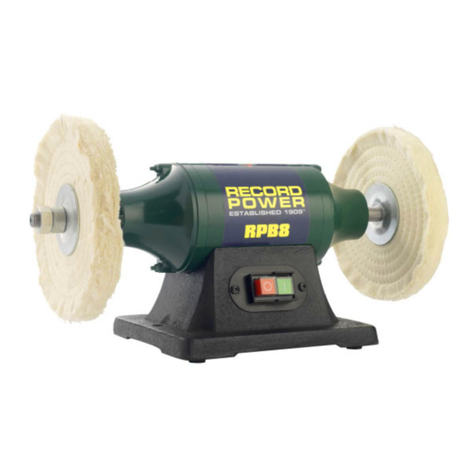
Record Power
Record Power RPB8 Original instruction manual

Ingersoll-Rand
Ingersoll-Rand 311A Product information
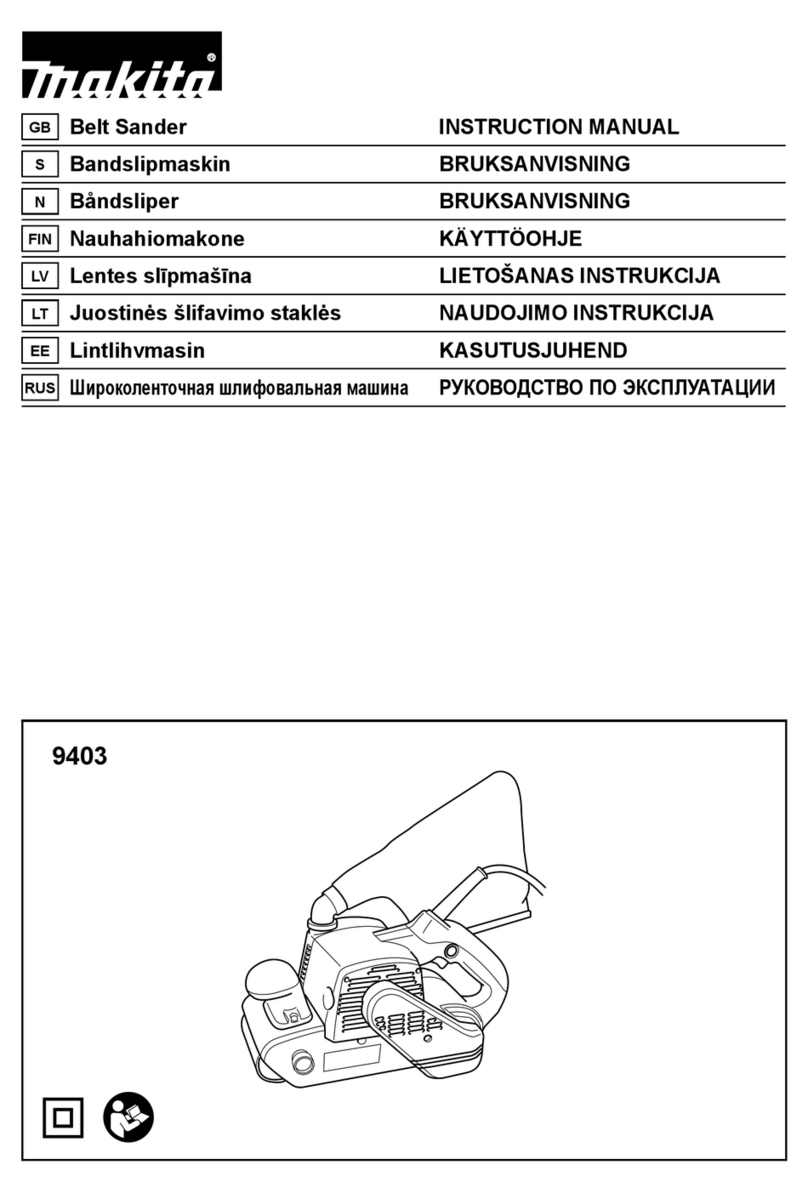
Makita
Makita 9403 instruction manual
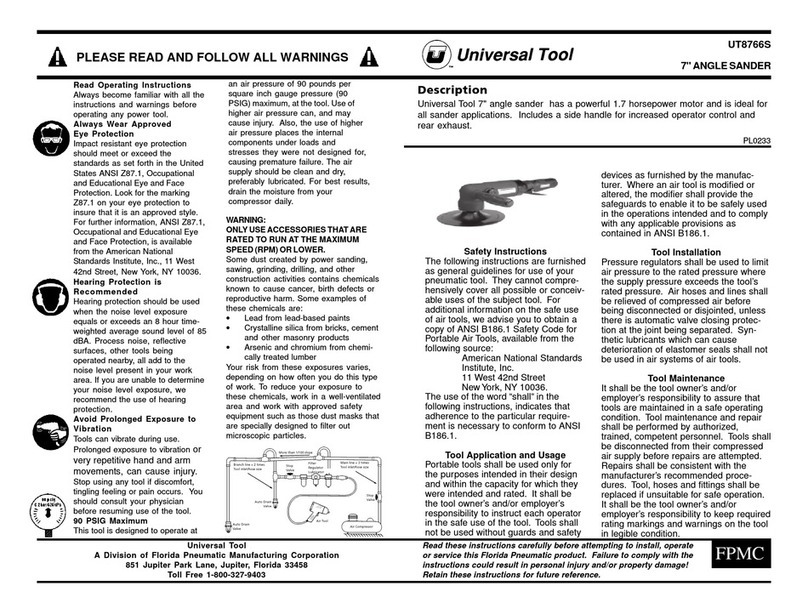
Universal Tool
Universal Tool UT8766S operating instructions
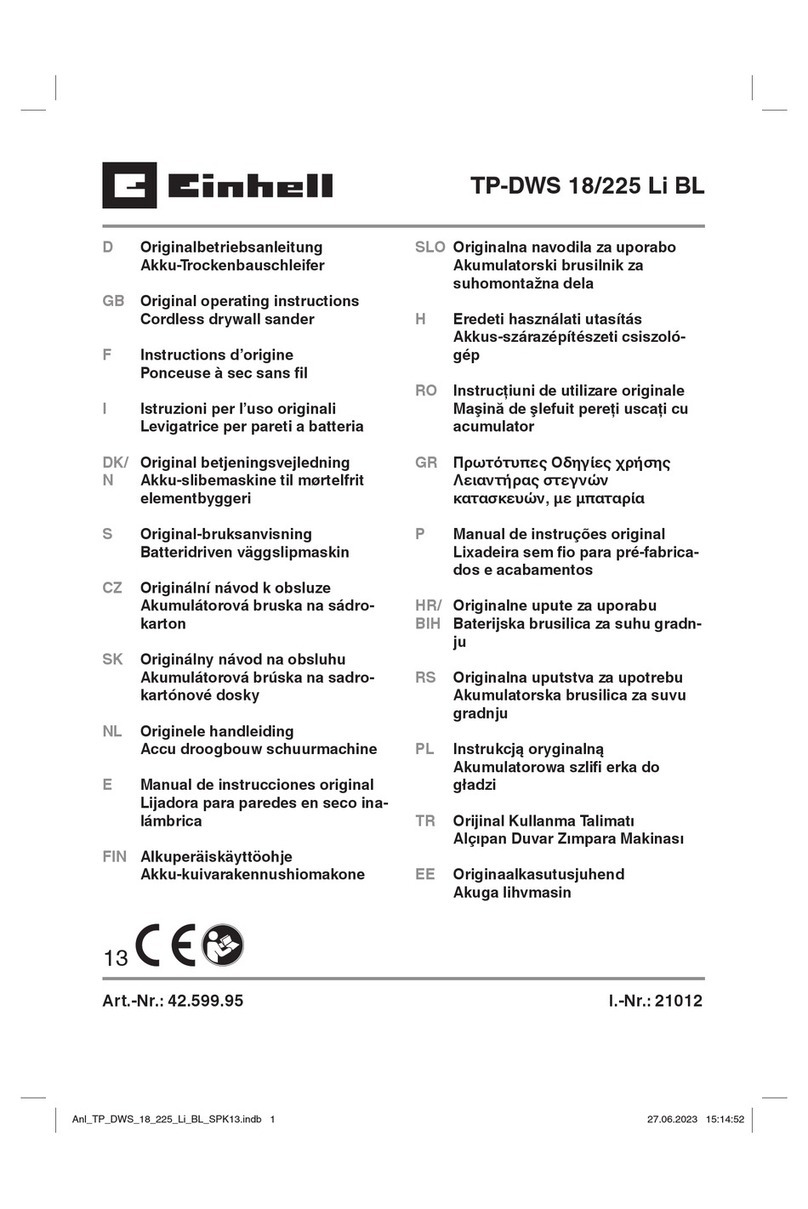
EINHELL
EINHELL TP-DWS 18/225 Li BL Original operating instructions
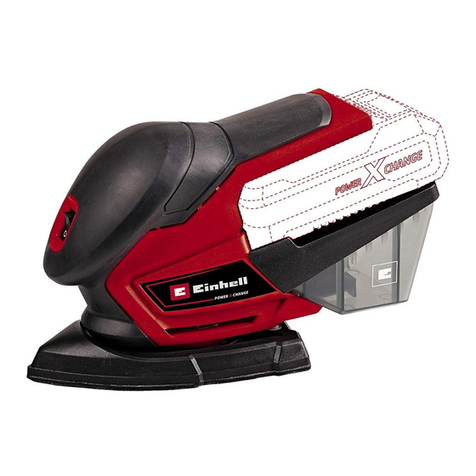
EINHELL
EINHELL TE-OS 18/150 Li operating instructions

Black & Decker
Black & Decker DS321 instruction manual
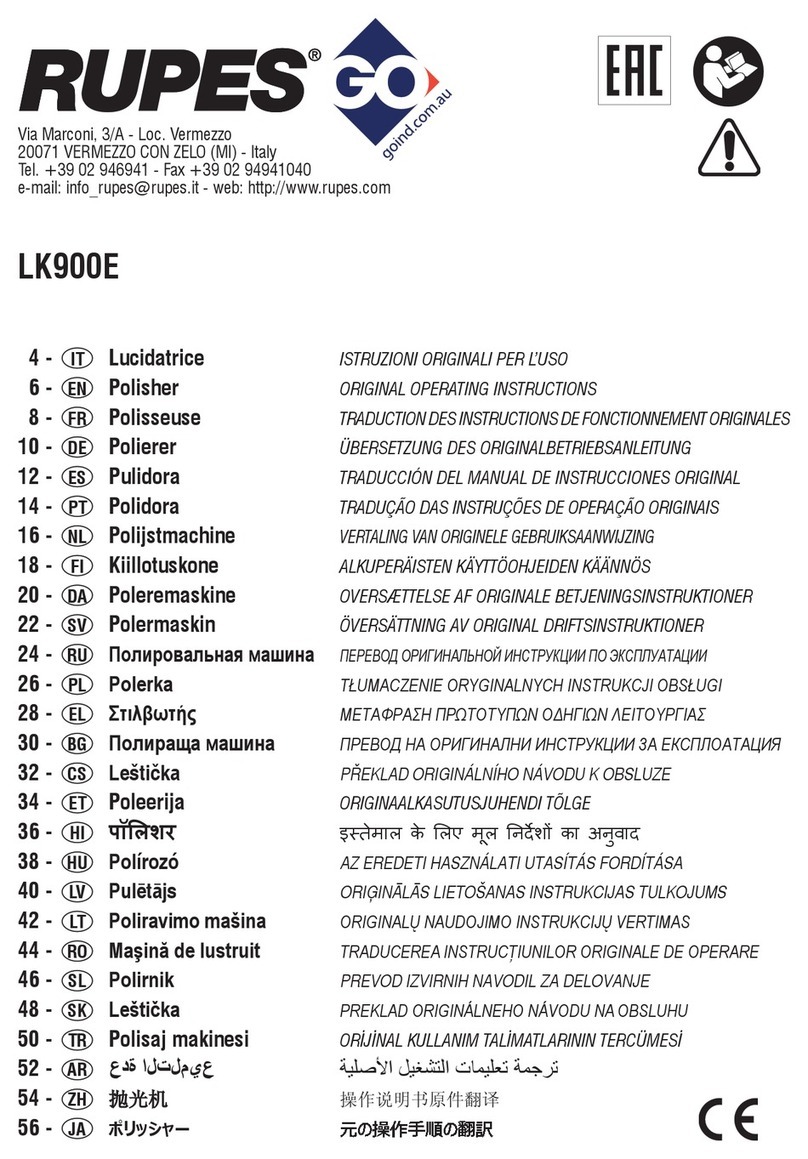
Rupes
Rupes LK900E Original operating instructions
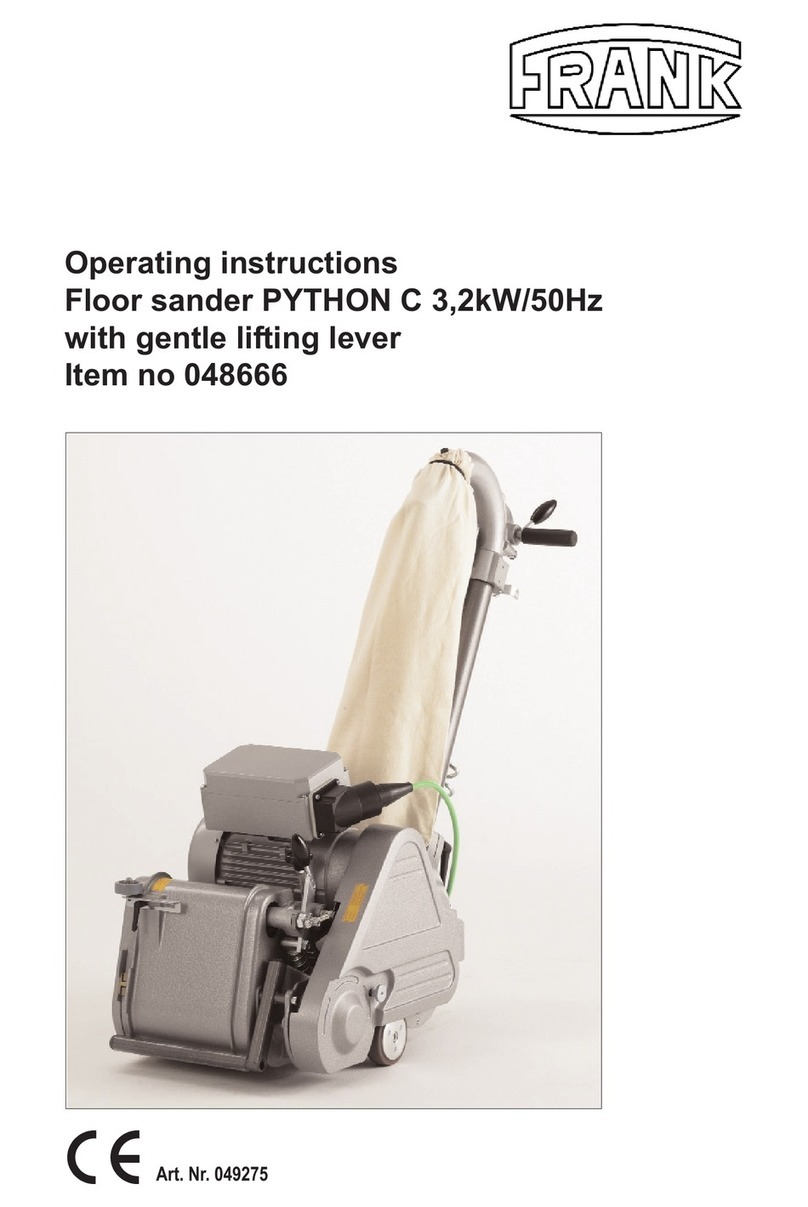
Frank
Frank PYTHON C 048666 operating instructions
